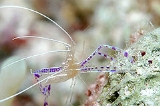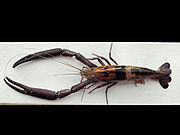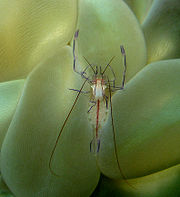
Palaemonidae
Encyclopedia
Palaemonidae is a family
of crustacean
s of the order
Decapoda
. They belong to the infraorder Caridea, which contains the true shrimp; while some freshwater
palaemonid species
are known as "prawn
s", the family belongs to the suborder Pleocyemata
like all true shrimp, whereas the true prawns are members of the suborder Dendrobranchiata.
Two subfamilies are distinguished: Palaemoninae and Pontoniinae. The Palaemoninae are mainly carnivore
s that eat small invertebrate
s and can be found in any aquatic
habitat
except the deep sea
. The most significant palaemonine genus is Macrobrachium
, which contains commercial species such as Macrobrachium rosenbergii.
The Pontoniinae inhabit coral reef
s, where they associate with certain invertebrate
s such as sponges, cnidaria
ns, mollusks and echinoderm
s. This group includes cleaner shrimp
s as well as parasites and commensals. They generally feed on detritus
, though some are carnivores and hunt tiny animals.

 The family contains 134 genera, divided unevenly between two subfamilies:
The family contains 134 genera, divided unevenly between two subfamilies:
Palaemoninae Rafinesque, 1815
Pontoniinae Kingsley, 1879
Family (biology)
In biological classification, family is* a taxonomic rank. Other well-known ranks are life, domain, kingdom, phylum, class, order, genus, and species, with family fitting between order and genus. As for the other well-known ranks, there is the option of an immediately lower rank, indicated by the...
of crustacean
Crustacean
Crustaceans form a very large group of arthropods, usually treated as a subphylum, which includes such familiar animals as crabs, lobsters, crayfish, shrimp, krill and barnacles. The 50,000 described species range in size from Stygotantulus stocki at , to the Japanese spider crab with a leg span...
s of the order
Order (biology)
In scientific classification used in biology, the order is# a taxonomic rank used in the classification of organisms. Other well-known ranks are life, domain, kingdom, phylum, class, family, genus, and species, with order fitting in between class and family...
Decapoda
Decapoda
The decapods or Decapoda are an order of crustaceans within the class Malacostraca, including many familiar groups, such as crayfish, crabs, lobsters, prawns and shrimp. Most decapods are scavengers. It is estimated that the order contains nearly 15,000 species in around 2,700 genera, with...
. They belong to the infraorder Caridea, which contains the true shrimp; while some freshwater
Freshwater
Fresh water is naturally occurring water on the Earth's surface in ice sheets, ice caps, glaciers, bogs, ponds, lakes, rivers and streams, and underground as groundwater in aquifers and underground streams. Fresh water is generally characterized by having low concentrations of dissolved salts and...
palaemonid species
Species
In biology, a species is one of the basic units of biological classification and a taxonomic rank. A species is often defined as a group of organisms capable of interbreeding and producing fertile offspring. While in many cases this definition is adequate, more precise or differing measures are...
are known as "prawn
Prawn
Prawns are decapod crustaceans of the sub-order Dendrobranchiata. There are 540 extant species, in seven families, and a fossil record extending back to the Devonian...
s", the family belongs to the suborder Pleocyemata
Pleocyemata
Pleocyemata is a sub-order of decapod crustaceans, erected by Martin Burkenroad in 1963. Burkenroad's classification replaced the earlier sub-orders of Natantia and Reptantia with the monophyletic groups Dendrobranchiata and Pleocyemata...
like all true shrimp, whereas the true prawns are members of the suborder Dendrobranchiata.
Two subfamilies are distinguished: Palaemoninae and Pontoniinae. The Palaemoninae are mainly carnivore
Carnivore
A carnivore meaning 'meat eater' is an organism that derives its energy and nutrient requirements from a diet consisting mainly or exclusively of animal tissue, whether through predation or scavenging...
s that eat small invertebrate
Invertebrate
An invertebrate is an animal without a backbone. The group includes 97% of all animal species – all animals except those in the chordate subphylum Vertebrata .Invertebrates form a paraphyletic group...
s and can be found in any aquatic
Aquatic ecosystem
An aquatic ecosystem is an ecosystem in a body of water. Communities of organisms that are dependent on each other and on their environment live in aquatic ecosystems. The two main types of aquatic ecosystems are marine ecosystems and freshwater ecosystems....
habitat
Habitat
* Habitat , a place where a species lives and grows*Human habitat, a place where humans live, work or play** Space habitat, a space station intended as a permanent settlement...
except the deep sea
Deep sea
The deep sea, or deep layer, is the lowest layer in the ocean, existing below the thermocline and above the seabed, at a depth of 1000 fathoms or more. Little or no light penetrates this part of the ocean and most of the organisms that live there rely for subsistence on falling organic matter...
. The most significant palaemonine genus is Macrobrachium
Macrobrachium
Macrobrachium is a genus of freshwater shrimp characterised by the extreme enlargement of the second pair of pereiopods, at least in the male...
, which contains commercial species such as Macrobrachium rosenbergii.
The Pontoniinae inhabit coral reef
Coral reef
Coral reefs are underwater structures made from calcium carbonate secreted by corals. Coral reefs are colonies of tiny living animals found in marine waters that contain few nutrients. Most coral reefs are built from stony corals, which in turn consist of polyps that cluster in groups. The polyps...
s, where they associate with certain invertebrate
Invertebrate
An invertebrate is an animal without a backbone. The group includes 97% of all animal species – all animals except those in the chordate subphylum Vertebrata .Invertebrates form a paraphyletic group...
s such as sponges, cnidaria
Cnidaria
Cnidaria is a phylum containing over 9,000 species of animals found exclusively in aquatic and mostly marine environments. Their distinguishing feature is cnidocytes, specialized cells that they use mainly for capturing prey. Their bodies consist of mesoglea, a non-living jelly-like substance,...
ns, mollusks and echinoderm
Echinoderm
Echinoderms are a phylum of marine animals. Echinoderms are found at every ocean depth, from the intertidal zone to the abyssal zone....
s. This group includes cleaner shrimp
Cleaner shrimp
Cleaner shrimp is a generic term for any swimming decapod crustacean that cleans other organisms of parasites. This is a widely-cited example of symbiosis: a relationship in which both parties benefit. The fish benefit by having parasites removed from them, and the shrimp gain the nutritional value...
s as well as parasites and commensals. They generally feed on detritus
Detritus
Detritus is a biological term used to describe dead or waste organic material.Detritus may also refer to:* Detritus , a geological term used to describe the particles of rock produced by weathering...
, though some are carnivores and hunt tiny animals.
Genera


Palaemoninae Rafinesque, 1815
- AlburniaAlburniaAlburnia is an extinct genus of shrimp in the order Decapoda. It contains the species Alburnia petinensis....
† Bravi & Garassino, 1998 - BechlejaBechlejaBechleja is an extinct genus of shrimp which existed during the Eocene period. It contains four species....
† Houša, 1957 - BeurleniaBeurleniaBeurlenia araripensis is an extinct species of shrimp in its own genus, Beurlenia....
† Martins-Neto & Mezzalira, 1991 - Brachycarpus Bate, 1888
- Coutierella Sollaud, 1914
- Creaseria Holthuis, 1950
- Cryphiops Dana, 1852
- Exopalaemon Holthuis, 1950
- Leander E. Desmarest, 1849
- Leandrites Holthuis, 1950
- Leptocarpus Holthuis, 1950
- MacrobrachiumMacrobrachiumMacrobrachium is a genus of freshwater shrimp characterised by the extreme enlargement of the second pair of pereiopods, at least in the male...
Bate, 1868 - Micropsalis † von Meyer, 1859
- Nematopalaemon Holthuis, 1950
- Neopalaemon Hobbs, 1973
- PalaemonPalaemon (genus)Palaemon is a genus of shrimp of the family Palaemonidae, containing the following species:*Palaemon adspersus Rathke, 1837*Palaemon affinise H. Milne-Edwards, 1837*Palaemon capensis Palaemon is a genus of shrimp of the family Palaemonidae, containing the following species:*Palaemon adspersus...
Weber, 1795 - PalaemonetesPalaemonetesThe genus Palaemonetes includes a geographically diverse group of fresh and brackish-water shrimp. It includes the following species:*Palaemonetes africanus Balss, 1916*Palaemonetes antennarius The genus Palaemonetes includes a geographically diverse group of fresh and brackish-water shrimp. It...
Heller, 1869 - Propalaemon † Woodward, 1903
- Pseudocaridinella † Martins-Neto & Mezzalira, 1991
- Pseudopalaemon Sollaud, 1911
- Schmelingia † Schweigert, 2002
- Troglindicus Sankolli & Shenoy, 1979
- Troglocubanus Holthuis, 1949
- Troglomexicanus Villalobos, Alvarez & Iliffe, 1999
- Urocaridella Borradaile, 1915
- YongjiacarisYongjiacarisYongjiacaris zhejiangensis is an extinct species of shrimp, and the only species in the genus Yongjiacaris. Yongjiacaris represents the second report of freshwater caridean shrimp from the Mesozoic....
† Garassino, Shen, Schram & Taylor, 2002
Pontoniinae Kingsley, 1879
- Allopontonia Bruce, 1972
- Altopontonia Bruce, 1990
- Amphipontonia Bruce, 1991
- Anapontonia Bruce, 1966
- Anchiopontonia Bruce, 1992
- Anchistus Borradaile, 1898
- Apopontonia Bruce, 1976
- Araiopontonia Fujino & Miyake, 1970
- Ascidonia Fransen, 2002
- Balssia Kemp, 1922
- Blepharocaris Mitsuhashi & Chan, 2007
- Brucecaris Marin & Chan, 2006
- Bruceonia Fransen, 2002
- Cainonia Bruce, 2005
- Carinopontonia Bruce, 1988
- Chacella Bruce, 1986
- Chernocaris Johnson, 1967
- Climeniperaeus Bruce, 1995
- Colemonia Bruce, 2005
- Conchodytes Peters, 1852
- Coralliocaris Stimpson, 1860
- Coutierea Nobili, 1901
- Crinotonia Marin, 2006
- Ctenopontonia Bruce, 1979
- Cuapetes A. H. Clark, 1919
- Dactylonia Fransen, 2002
- Dasella Lebour, 1945
- Dasycaris Kemp, 1922
- Diapontonia Bruce, 1986
- Epipontonia Bruce, 1977
- Eupontonia Bruce, 1971
- Exoclimenella Bruce, 1995
- Exopontonia Bruce, 1988
- Fennera Holthuis, 1951
- Hamiger Borradaile, 1916
- Hamodactyloides Fujino, 1973
- Hamodactylus Holthuis, 1952
- Hamopontonia Bruce, 1970
- Harpiliopsis Borradaile, 1917
- Harpilius Dana, 1852
- Ischnopontonia Bruce, 1966
- Isopontonia Bruce, 1982
- Izucaris Okuno, 1999
- Jocaste Holthuis, 1952
- LaomenesLaomenesLaomenes is a genus of shrimp comprising the following species:*Laomenes amboinensis *Laomenes ceratophthalmus *Laomenes clarki Marin, 2009*Laomenes cornutus...
A. H. Clark, 1919 - Leptomenaeus Bruce, 2007
- Lipkebe Chace, 1969
- Manipontonia Bruce, Okuno & Li, 2005
- Margitonia Bruce, 2007
- Mesopontonia Bruce, 1967
- Metapontonia Bruce, 1967
- Miopontonia Bruce, 1985
- Neoanchistus Bruce, 1975
- Neopericlimenes Heard, Spotte & Bubucis, 1993
- Neopontonides Holthuis, 1951
- Nippontonia Bruce & Bauer, 1997
- Notopontonia Bruce, 1991
- Odontonia Fransen, 2002
- Onycocaridella Bruce, 1981
- Onycocaridites Bruce, 1987
- Onycocaris Nobili, 1904
- Onycomenes Bruce, 2009
- Orthopontonia Bruce, 1982
- Palaemonella Dana, 1852
- Paraclimenaeus Bruce, 1988
- Paraclimenes Bruce, 1995
- Paranchistus Holthuis, 1952
- Paratypton Balss, 1914
- Patonia Mitsuhashi & Chan, 2006
- Periclimenaeus Borradaile, 1915
- Periclimenella Bruce, 1995
- PericlimenesPericlimenesThe genus Periclimenes contains a large number of species of shrimp that live symbiotically with larger animals, most commonly sea anemones, though some corals, sea stars, sea cucumbers and, in the case of the imperial shrimp, P...
Costa, 1844
- Periclimenoides Bruce, 1990
- Philarius Holthuis, 1952
- Phycomenes Bruce, 2008
- Platycaris Holthuis, 1952
- Platypontonia Bruce, 1968
- Plesiopontonia Bruce, 1985
- Pliopontonia Bruce, 1973
- Pontonia Latreille, 1829
- Pontonides Borradaile, 1917
- Pontoniopsides Bruce, 2005
- Pontoniopsis Borradaile, 1915
- Poripontonia Fransen, 2003
- Propontonia Bruce, 1969
- Pseudoclimenes Bruce, 2008
- Pseudocoutierea Holthuis, 1951
- Pseudopontonia Bruce, 1992
- Pseudopontonides Heard, 1986
- Pseudoveleronia Marin, 2008
- Rapipontonia Marin, 2007
- Rostronia Fransen, 2002
- Sandimenes Li, 2009
- Sandyella Marin, 2009
- Stegopontonia Nobili, 1906
- Tectopontonia Bruce, 1973
- Thaumastocaris Kemp, 1922
- Tuleariocaris Hipeau-Jacquotte, 1965
- Typton Costa, 1844
- Typtonychus Bruce, 1996
- Unguicaris Marin & Chan, 2006
- Urocaris Stimpson, 1860
- Veleronia Holthuis, 1951
- Veleroniopsis Gore, 1981
- Vir Holthuis, 1952
- Waldola Holthuis, 1951
- Yemenicaris Bruce, 1997
- Zenopontonia Bruce, 1975

